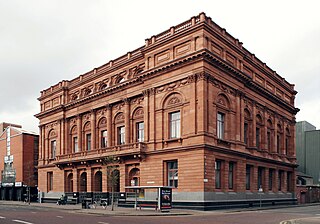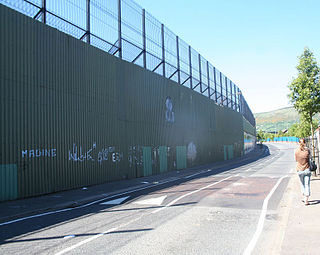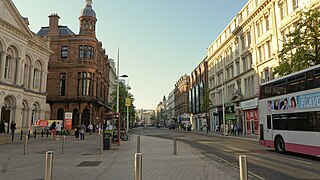
Belfast is the capital city and principal port of Northern Ireland, standing on the banks of the River Lagan and connected to the open sea through Belfast Lough and the North Channel. It is the second-largest city on the island of Ireland, with an estimated population of 348,005 in 2022, and a metropolitan area population of 671,559.

The Queen's University of Belfast, commonly known as Queen's University Belfast, is a public research university in Belfast, Northern Ireland, United Kingdom. The university received its charter in 1845 as "Queen's College, Belfast", and opened four years later.

Norwood, also known as Bainbridge, is a residential neighborhood in the northwest Bronx, New York City, U.S. It is bound by Van Cortlandt Park and Woodlawn Cemetery to the north, the Bronx River to the east, and Mosholu Parkway to the southwest. The area is dominated topographically by what was once Valentine's Hill, the highest point being near the intersection of 210th Street and Bainbridge Avenue, where Gun Hill Road intersects, and around the Montefiore Medical Center, the largest landowner and employer of the neighborhood. Norwood's main commercial arteries are Gun Hill Road, Jerome Avenue, Webster Avenue, and Bainbridge Avenue.

The Falls Road is the main road through West Belfast, Northern Ireland, running from Divis Street in Belfast City Centre to Andersonstown in the suburbs. The name has been synonymous for at least a century and a half with the Catholic community in the city. The road is usually referred to as the Falls Road, rather than as Falls Road. It is known in Irish as the Bóthar na bhFál and as the Faas Raa in Ulster-Scots.
Belfast City Centre is the central business district of Belfast, Northern Ireland.

Belfast City Hall is the civic building of Belfast City Council located in Donegall Square, Belfast, Northern Ireland. It faces North and effectively divides the commercial and business areas of the city centre. It is a Grade A listed building.

Belfast Central Library is a public library in Royal Avenue, Belfast, Northern Ireland. Opened in 1888, it was one of the first major public library buildings in Ireland.

Cregagh is an area in the southeast of Belfast, Northern Ireland. It is the name of a townland and has been adopted as the name of an electoral ward of Belfast City council. The townland dates back to medieval times, when it was part of the territory held by the O'Neills of Clannaboy. The area is centred on the Cregagh Road. The Woodstock/Cregagh Road is a continuous arterial route in the city, with the Woodstock making up the lower half of the route and the Cregagh the upper half. It runs from the Albertbridge Road, close to the Short Strand, to the A55 Outer Ring road.

The Cathedral Quarter in Belfast, Northern Ireland, is a developing area of the city, roughly situated between Royal Avenue near where the Belfast Central Library building is, and the Dunbar Link in the city centre. From one of its corners, the junction of Royal Avenue, Donegall Street and York Street, the Cathedral Quarter lies south and east. Part of the area, centred on Talbot Street behind the cathedral, was formerly called the Half Bap. The "Little Italy" area was on the opposite side of Great Patrick Street centred on Little Patrick Street and Nelson Street.

Titanic Quarter in Belfast, Northern Ireland, is a large-scale waterfront regeneration, comprising historic maritime landmarks, film studios, education facilities, apartments, a riverside entertainment district, and the world's largest Titanic-themed attraction centred on land in Belfast Harbour, known until 1995 as Queen's Island. The 185-acre (75 ha) site, previously occupied by part of the Harland and Wolff shipyard, is named after the company's, and the city's, most famous product, RMS Titanic. Titanic Quarter is part of the Dublin-based group, Harcourt Developments, which has held the development rights since 2003.
The subdivisions of Belfast are a series of divisions of Belfast, Northern Ireland that are used for a variety of cultural, electoral, planning and residential purposes.

The Belfast quarters are distinctive cultural zones within the city of Belfast, Northern Ireland, whose identities have been developed as a spur to tourism and urban regeneration. These "quarters" differ from the traditional districts into which Belfast is divided.
The Gaeltacht Quarter in Belfast, Northern Ireland, is an area surrounding the Falls Road in the west of the city. A Gaeltacht is an area where the Irish language is spoken. Unlike the traditional Gaeltacht areas in the Republic of Ireland, Belfast's Gaeltacht Quarter does not have legally defined geographical boundaries. The Quarter serves as a socio-linguistic hub focused on the Falls Road/Andersonstown Road corridor in the west of the city, and aims to promote Irish language and Irish culture in the area and to develop associated tourist attractions.

Interface area is the name given in Northern Ireland to areas where segregated nationalist and unionist residential areas meet. They have been defined as "the intersection of segregated and polarised working class residential zones, in areas with a strong link between territory and ethno-political identity".
The Tribeca Belfast development, formerly known as North East Quarter and previously Royal Exchange, is a planned £500 million development based in the north east of Belfast City Centre. It is a major mixed-use regeneration scheme, with a total area of 1.5 million sq ft (0.14 million m2) as of 2018. The development has generated controversy since its inception in 2003. Over the years, opposition has been levelled against its lack of care towards existing important built heritage, lack of integration with local small businesses and arts organisations and even its brand name, and much of its existence so far has been in the context of an arson attack on one of the existing buildings in 2004, while under the ownership of the developers.

The Linen Quarter is an area of Belfast, Northern Ireland. The name is derived from the great many linen warehouses that are still present in the area. The Linen Quarter is host to some of the major cultural venues of Belfast, including the Ulster Hall and Grand Opera House, alongside a large number of hotels, bars, restaurants and cafes. The district also includes the main transport hub of Belfast.
Smithfield and Union is one of the quarters of Belfast, Northern Ireland, established by Belfast City Council in the 21st century. Initially designated the Smithfield Market and Library quarter, the current name was adopted in 2011. Based around the north of Belfast City Centre it extends from North Street to Frederick Street and is bounded by Royal Avenue/York Street and Carrick Hill/Millfield. It houses Belfast Central Library and two of the main daily newspapers The Irish News and The Belfast Telegraph.

Niall Ó Donnghaile is an Irish Sinn Féin politician who served as a Senator for the Administrative Panel from 2016 to 2024. He was the Leader of Sinn Féin in the Seanad from June 2020 to January 2024. He previously served as Lord Mayor of Belfast from 2011 to 2012 and a Councillor on Belfast City Council from 2011 to 2016.

Royal Avenue is a street in the heart of Belfast city centre, Northern Ireland. It runs for about 500 metres from the junction with Castle Place and Donegall Place to the junction with Donegall Street. It lies between the Cathedral Quarter and the Smithfield and Union Quarter of the city. It has been the city's principal shopping thoroughfare since its establishment in 1881. Today Royal Avenue is one of Belfast's main commercial centres and is home to the £40 million shopping complex Westfield CastleCourt.

Glider is a bus rapid transit system in Belfast, Northern Ireland, designed to improve the efficiency of mass transit in the city by connecting East and West Belfast and the Titanic Quarter via the city centre. The service is operated by Translink.














